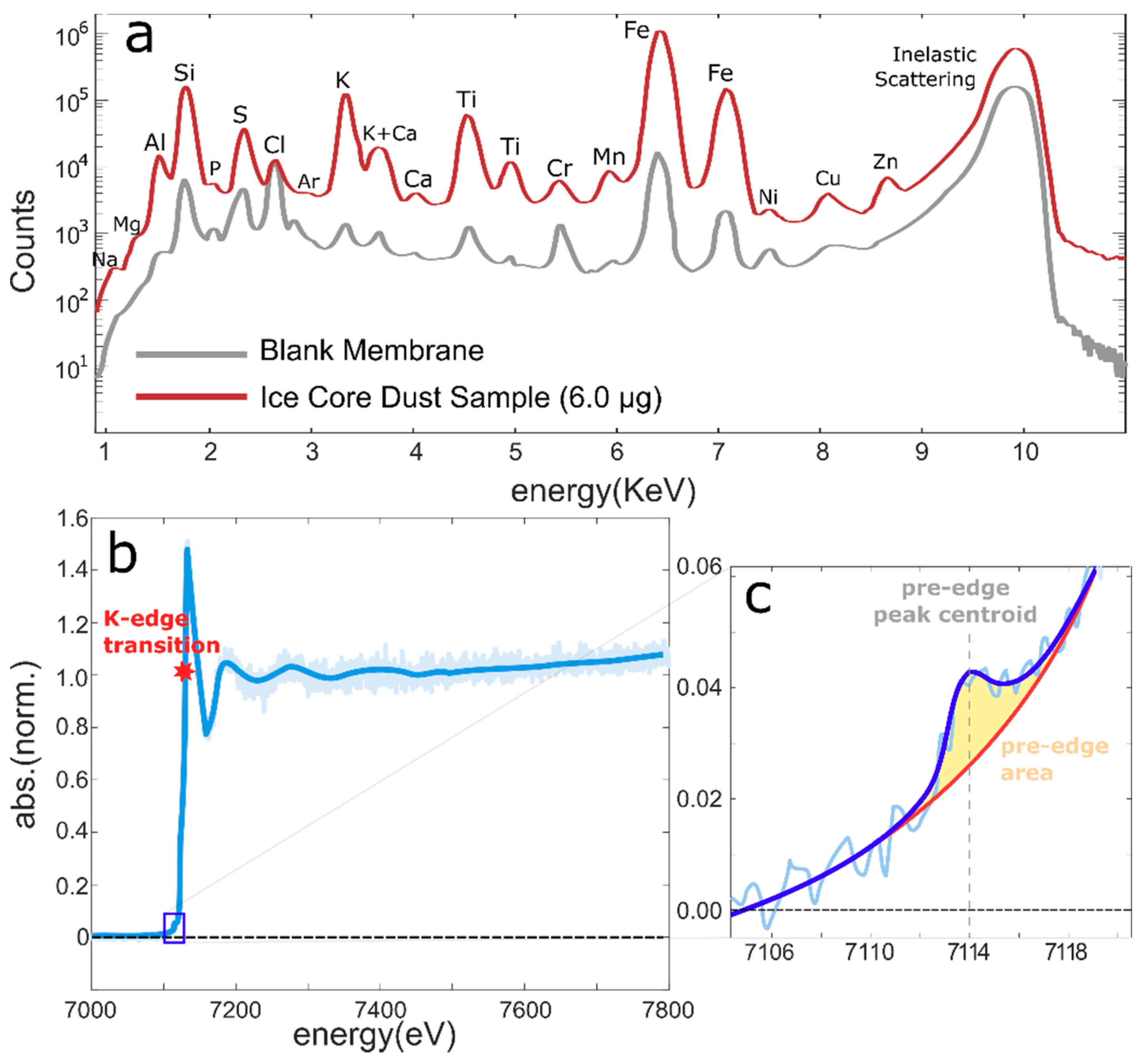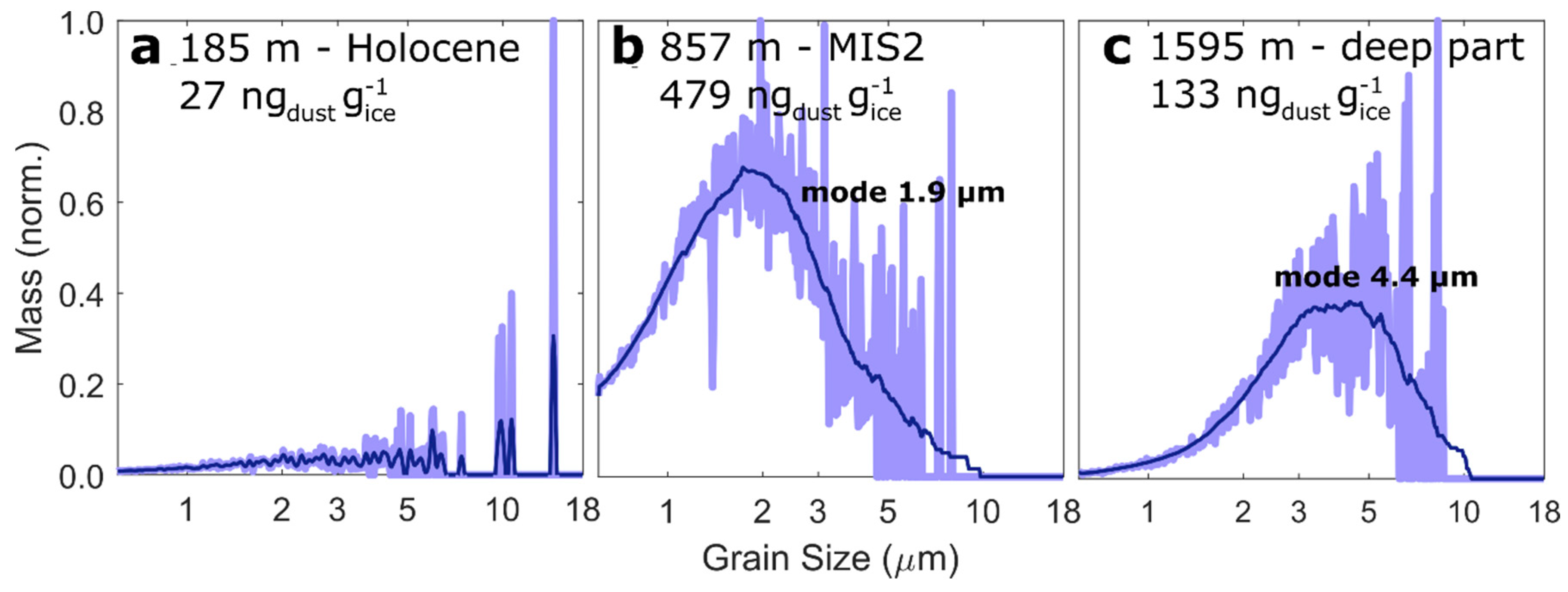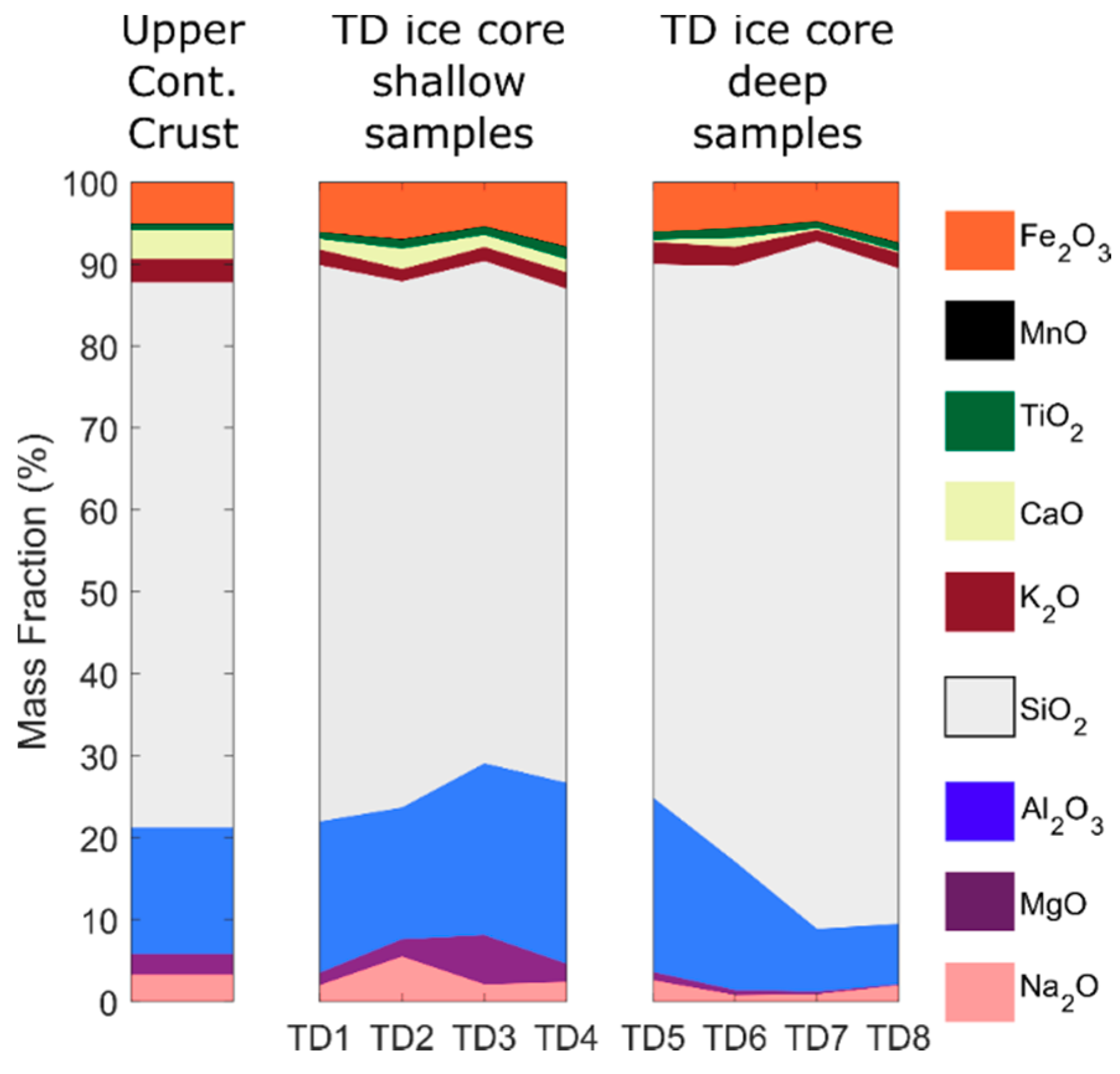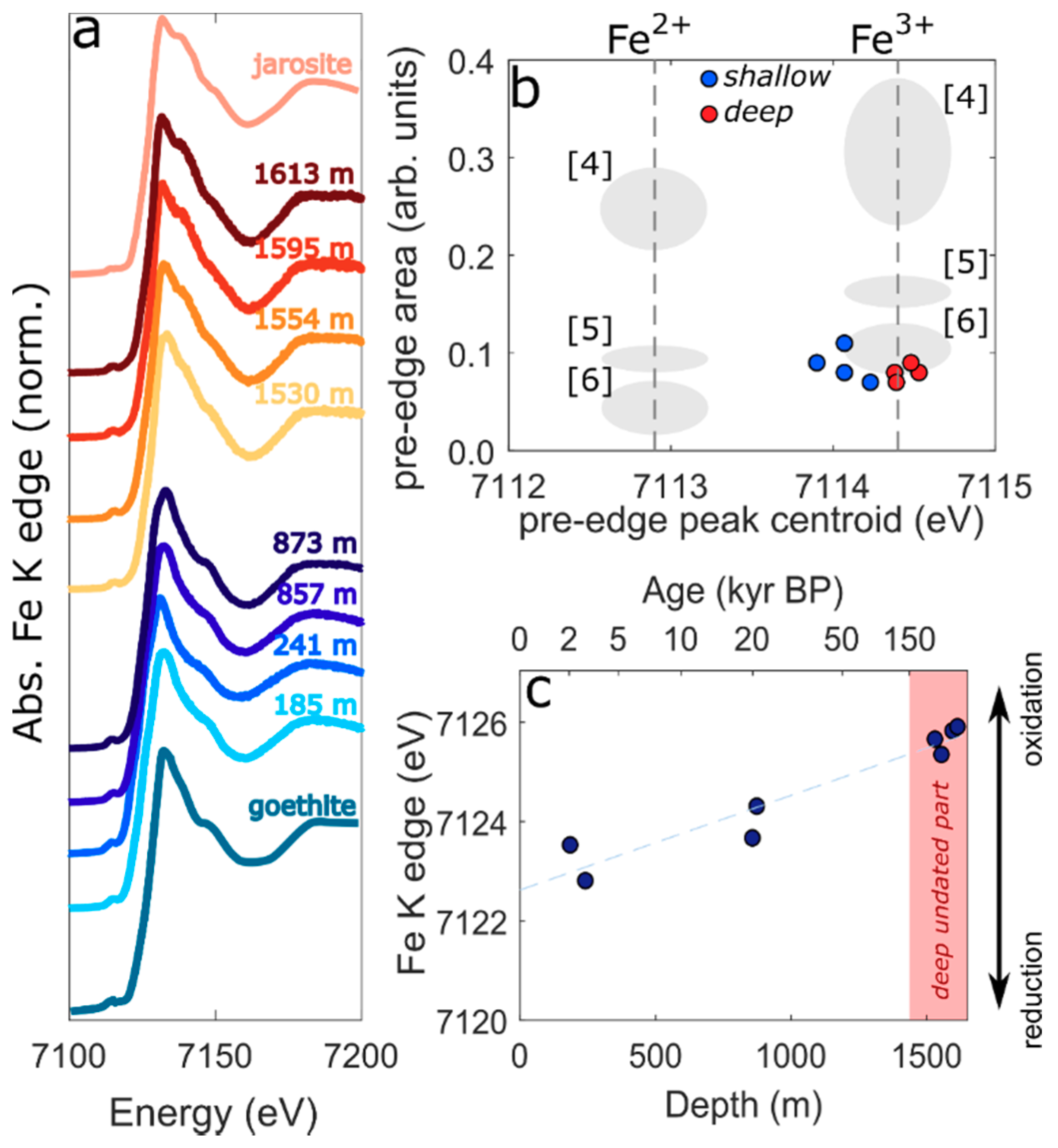The Contribution of Synchrotron Light for the Characterization of Atmospheric Mineral Dust in Deep Ice Cores: Preliminary Results from the Talos Dome Ice Core (East Antarctica)
Abstract
:1. Introduction
2. Materials and Methods
2.1. The Talos Dome Ice Core
2.2. Coulter Counter
2.3. Synchrotron Light Measurements
3. Results and Discussion
3.1. Grain Size Distributions
3.2. Dust Composition
3.3. Iron Geochemistry
4. Conclusions and Perspectives
Author Contributions
Acknowledgments
Conflicts of Interest
References
- Arimoto, R. Eolian dust and climate: Relationships to sources, tropospheric chemistry, transport and deposition. Earth Sci. Rev. 2001, 54, 29–42. [Google Scholar] [CrossRef]
- Jickells, T.D.; An, Z.S.; Andersen, K.K.; Baker, A.R.; Bergametti, G.; Brooks, N.; Cao, J.J.; Boyd, P.W.; Duce, R.A.; Hunter, K.A.; et al. Global iron connections between desert dust, ocean biogeochemistry and climate. Science 2005, 308, 67–71. [Google Scholar] [CrossRef] [PubMed]
- Maher, B.A.; Prospero, J.M.; Mackie, D.; Gaiero, D.; Hesse, P.P.; Balkanski, Y. Global connections between aeolian dust, climate and ocean biogeochemistry at the present day and at the last glacial maximum. Earth-Sci. Rev. 2010, 99, 61–97. [Google Scholar] [CrossRef]
- Lambert, F.; Delmonte, B.; Petit, J.R.; Bigler, M.; Kaufmann, P.R.; Hutterli, M.A.; Stocker, T.F.; Ruth, U.; Steffensen, J.P.; Maggi, V. Dust-climate couplings over the past 800.000 years from the EPICA Dome C ice core. Nature 2008, 452, 616–619. [Google Scholar] [CrossRef] [PubMed] [Green Version]
- Fischer, H.; Fundel, F.; Ruth, U.; Twarloh, B.; Wegner, A.; Udisti, R.; Becagli, S.; Castellano, E.; Morganti, A.; Severi, M.; et al. Reconstruction of millenial changes in dust emission, transport and regional sea ice coverage using the depp EPICA ice cores from the Atlantic and Inidian Ocean secont of Antarctica. Earth Planet. Sci. Lett. 2007, 260, 340–354. [Google Scholar] [CrossRef] [Green Version]
- Wegner, A.; Fischer, H.; Delmonte, B.; Petit, J.R.; Erhardt, T.; Ruth, U.; Svensson, A.; Vinther, B.; Miller, H. The role of seasonality of mineral dust concentration and size on glacial/interglacial dust changes in the EPICA Dronning Maud Land ice core. J. Geophys. Res. 2015, 120. [Google Scholar] [CrossRef]
- Epica Community Members. Eight glacial cycles from an Antarctic ice core. Nature 2004, 429, 623–628. [Google Scholar] [CrossRef] [PubMed] [Green Version]
- Jouzel, J.; Masson-Delmotte, V.; Cattani, O.; Dreyfus, G.; Falourd, S.; Hoffmann, G.; Minster, B.; Nouet, J.; Barnola, J.M.; Chappellaz, J.; et al. Orbital and millennial Antarctic climate variability over the past 800,000 years. Nature 2007, 317, 793–796. [Google Scholar] [CrossRef] [PubMed] [Green Version]
- Faria, S.H.; Freitag, J.; Kipstul, S. Polar ice structure and the integrity of ice-core paleoclimate records. Quat. Sci. Rev. 2010, 29, 338–351. [Google Scholar] [CrossRef]
- De Angelis, M.; Tison, J.L.; Morel-Fourcade, M.C.; Susini, J. Micro-investigation of EPICA Dome C bottom ice: Evidence of long term in situ processes involving acid-salt interactions, mineral dust, and organic matter. Quat. Sci. Rev. 2013, 78, 248–265. [Google Scholar] [CrossRef]
- Tison, J.L.; de Angelis, M.; Littot, G.; Wolff, E.; Fischer, H.; Hansson, M.; Bigler, M.; Udisti, R.; Wegner, A.; Jouzel, J.; et al. Retrieving the paleoclimatic signal from the deeper part of the EPICA Dome C ice core. Cryosphere 2015, 9, 1633–1648. [Google Scholar] [CrossRef] [Green Version]
- Goossens, T.; Sapart, C.J.; Dahl-Jensen, D.; Popp, T.; El Amri, S.; Tison, J.L. A comprehensive interpretation of the NEEM basal ice build-up using a multi-parametric approach. Cryosphere 2016, 10, 553–567. [Google Scholar] [CrossRef] [Green Version]
- Frezzotti, M.; Bitelli, G.; De Michelis, P.; Deponti, A.; Forieri, A.; Gandolfi, S.; Maggi, V.; Mancini, F.; Remy, F.; Tabacco, I.; et al. Geophysical survey at Talos Dome, East Antarctica: The search for a new deep-drilling site. Ann. Glaciol. 2004, 39, 423–432. [Google Scholar] [CrossRef]
- Stenni, B.; Buiron, D.; Frezzotti, M.; Albani, S.; Barbante, C.; Bard, E.; Barnola, J.M.; Baroni, M.; Baumgartner, M.; Bonazza, M.; et al. Expression of the bipolar see-saw in Antarctic climate record during the last deglaciation. Nat. Geosci. 2011, 4, 46–49. [Google Scholar] [CrossRef]
- Bazin, L.; Landais, A.; Lemieux-Dudon, B.; Toyé Mahamado Kele, H.; Veres, D.; Parrenin, F.; Martinerie, P.; Ritz, C.; Capron, E.; Lipenkov, V.; et al. An optimized multi-proxy, multi-site Antarctic ice and gas orbital chronology (AICC2012): 120–800 ka. Clim. Past 2013, 9, 1715–1721. [Google Scholar] [CrossRef] [Green Version]
- Veres, D.; Bazin, L.; Landais, A.; Toyé Mahamadou Kele, H.; Lemieux-Dudon, B.; Parrenin, F.; Martinerie, P.; Blayo, E.; Blunier, T.; Capron, E.; et al. The Antarctic ice core chornology (AICC2012): An optimized multi-parameter and multi-site dating approach for the last 120 thousands years. Clim. Past 2013, 9, 1733–1748. [Google Scholar] [CrossRef] [Green Version]
- Baccolo, G.; Clemenza, M.; Delmonte, B.; Maffezzoli, N.; Nastasi, M.; Previtali, E.; Maggi, V. A new method based on Low Background Instrumental Neutron Activation Analysis for major, trace and ultra-trace elements determination in atmospheric mineral dust from polar ice cores. Anal. Chim. Acta 2016, 922, 11–18. [Google Scholar] [CrossRef] [PubMed]
- Ruth, U.; Barbante, C.; Bigler, M.; Delmonte, B.; Fischer, H.; Gabrielli, P.; Gaspari, V.; Kaufmann, P.; Lambert, F.; Maggi, V.; et al. Proxies and measurement techinques for mineral dust in Antarctic ice cores. Environ. Sci. Technol. 2008, 42, 5675–5681. [Google Scholar] [CrossRef]
- Quartieri, S. Synchrotron Radiation in the Earth Sciences. In Synchrotron Radiation; Springer: Berlin, Germany, 2014; pp. 641–660. [Google Scholar]
- Hawkesworth, C.J.; Kemp, A.I.S. Evolution of the continental crust. Nature 2006, 443, 811–817. [Google Scholar] [CrossRef] [PubMed]
- Marino, F.; Castellano, E.; Ceccato, D.; De Deckker, P.; Delmonte, B.; Gheramandi, G.; Maggi, V.; Petit, J.R.; Revel-Rolland, M.; Udisti, R. Defining the geochemical composition of the EPICA Dome C ice core dust during the last glacial-interglacial cycle. Geochem. Geophys. Geosys. 2008, 9. [Google Scholar] [CrossRef] [Green Version]
- Boyd, P.W.; Ellwood, M.J. The biogeochemical cycle of iron in the ocean. Nat. Geosci. 2010, 3, 675–682. [Google Scholar] [CrossRef] [Green Version]
- Wolff, E.W.; Fischer, H.; Fundel, F.; Ruth, U.; Twarloh, B.; Littot, G.C.; Mulvaney, R.; Rothlisberger, R.; de Angelis, M.; Boutron, C.F.; et al. Southern Ocean sea-ice extent, productivity and iron flux over the past eight glacial cycles. Nature 2006, 440, 491–496. [Google Scholar] [CrossRef] [PubMed] [Green Version]
- Conway, T.M.; Wolff, E.W.; Röthlisberger, R.; Mulvaney, R.; Elderfield, H.E. Constraints on soluble aerosol iron flux to the Southern Ocean at the Last Glacial Maximum. Nat. Commun. 2015, 6. [Google Scholar] [CrossRef] [PubMed] [Green Version]
- Baccolo, G.; Maffezzoli, N.; Clemenza, M.; Delmonte, B.; Prata, M.; Salvini, A.; Maggi, V.; Previtali, E. Low background neutron activation analysis: A powerful tool for atmopsheric mineral dust analyisis in ice cores. J. Radioanal. Nucl. Chem. 2015, 306. [Google Scholar] [CrossRef]
- Macis, S.; Cibin, G.; Maggi, V.; Hampai, D.; Baccolo, G.; Delmonte, B.; D’Elia, A.; Marcelli, A. Microdrop deposition technique: Preparation and characterization of diluted suspended particulate samples. Condens. Matter 2018, 3, 21. [Google Scholar] [CrossRef]
- Dent, A.J.; Cibin, G.; Ramos, S.; Smith, A.D.; Scott, S.M.; Varandas, L.; Pearson, M.R.; Krumpa, N.A.; Jones, C.P.; Robbins, P.E. B18: A core XAS spectroscopy beamline for Diamond. J. Phys. Conf. Ser. 2009, 190. [Google Scholar] [CrossRef]
- Baccolo, G.; Delmonte, B.; Albani, S.; Baroni, C.; Cibin, G.; Frezzotti, M.; Hampai, D.; Marcelli, A.; Revel, M.; Salvatore, M.C.; et al. Regionalization of the atmospheric dust cycle on the periphery of the East Antarctic ice sheet since the last glacial maximum. Geochem. Geophy. Geosy. 2018, in press. [Google Scholar]
- Cibin, G.; Marcelli, A.; Maggi, V.; Sala, M.; Marino, F.; Delmonte, B.; Albani, S.; Pignotti, S. First combined total reflection X-ray fluorescence and grazing incidence X-ray absorption spectroscopy characterization of aeolian dust archived in Antarctica and Alpine deep ice cores. Spectrochim. Acta B 2008, 63, 1503–1510. [Google Scholar] [CrossRef]
- Marcelli, A.; Hampai, D.; Giannone, F.; Sala, M.; Maggi, V.; Marino, F.; Pignotti, F.; Cibin, G. XRF-XANES characterization of deep ice core insoluble dust. J. Anal. At. Spectrom. 2012, 27, 33–37. [Google Scholar] [CrossRef]
- Albani, S.; Delmonte, B.; Maggi, V.; Baroni, C.; Petit, J.R.; Stenni, B.; Mazzola, C.; Frezzotti, M. Interpreting last glacial to Holocene dust changes at Talos Dome (East Antarctica): Implications for atmospheric variations from regional to hemispheric scales. Clim. Past 2012, 8, 741–750. [Google Scholar] [CrossRef] [Green Version]
- Delmonte, B.; Baroni, C.; Andersson, P.S.; Shoberg, H.; Hansson, M.; Aciego, S.; Petit, J.R.; Albani, S.; Mazzola, C.; Maggi, V.; et al. Aeolian dust in the Talos Dome ice core (East Antarctica, Pacific/Ross Sea sector): Victoria Land versus remote sources over the last two climatic cycle. J. Quat. Sci. 2010, 25, 1327–1337. [Google Scholar] [CrossRef]
- Traversi, R.; Becagli, S.; Castellano, E.; Marino, F.; Rugi, F.; Severi, M.; de Angelis, M.; Fischer, H.; Hansson, M.; Stauffer, B.; et al. Sulfate spikes in the deep layers of EPICA-Dome C ice core: Evidence of glaciological artifacts. Environ. Sci. Technol. 2009, 43, 8737–8743. [Google Scholar] [CrossRef] [PubMed]
- Delmonte, B.; Petit, J.R.; Maggi, V. Glacial to Holocene implications of the new 27000-year dust record from the EPICA Dome C (East Atarctica) ice core. Clim. Dyn. 2002, 18, 647–660. [Google Scholar]
- Rudnick, R.L.; Gao, S. Composition of the continental crust. In Treatise on Geochemistry; Rudnick, R.L., Ed.; Elsevier: New York, NY, USA, 2003; Volume 3, pp. 1–64. [Google Scholar]
- Legrand, M.; Mayewski, P. Glaciochemistry of polar ice cores: A review. Rev. Geophys. 1997, 35, 219–243. [Google Scholar] [CrossRef] [Green Version]
- Rothlisberger, R.; Hutterli, A.; Sommer, S.; Wolff, E.W.; Mulvaney, R. Factors controlling nitrate in ice cores: Evidence from the Dome c deep ice core. J. Geophys. Res. 2000, 105, 20565–20572. [Google Scholar] [CrossRef]
- Delmonte, B.; Andersson, P.S.; Shoberg, H.; Hansson, M.; Petit, J.R.; Delmas, R.; Gaiero, D.M.; Maggi, V.; Frezzotti, M. Geographic provenance of aeolian dust in East Antarctica during Pleistocene glaciations: Preliminary results from Talos Dome and comparison with East Antarctic and new Andean ice core data. Quat. Sci. Rev. 2010, 29, 256–264. [Google Scholar] [CrossRef]
- Price, P.B. A habitat for psychrophiles in deep Antarctic ice. PNAS 2000, 97, 1247–1251. [Google Scholar] [CrossRef] [PubMed] [Green Version]
- Berry, A.J.; O’Neill, H.S.C.; Jayasuriya, K.D.; Campbell, S.J.; Foran, G.J. XANES calibrations for the oxidation state of iron in a silicate glass. Am. Mineral. 2003, 88, 967–977. [Google Scholar] [CrossRef]
- Chassé, M.; Griffin, W.L.; O’Reilly, S.Y.; Calas, G. Scandium speciation in a world-class lateritic deposit. Geochem. Perspect. Lett. 2017, 3, 105–114. [Google Scholar] [CrossRef]
- Johnstone, S.G.; Burton, E.D.; Keene, A.F.; Planer-Friedrich, B.; Voegelin, A.; Blackford, M.G.; Lumpkin, G.R. Arsenic mobilization and iron transformations during sulfidization of As (V)-bearing jarosite. Chem. Geol. 2012, 334, 9–24. [Google Scholar] [CrossRef]
- Wilke, M.; Farges, F.; Petit, P.E.; Brown, G.E., Jr.; Martin, F. Oxidation state and coordination of Fe in minerals: An Fe K-XANES spectroscopic study. Am. Mineral. 2001, 86, 714–730. [Google Scholar] [CrossRef]
- Giuli, G.; Eeckhout, S.G.; Paris, E.; Koeberl, C.; Pratesi, G. Iron oxidation state in impact glass from the K/T boundary at Beloc, Haiti, by high-resolution XANES spectroscopy. Meteorit. Planet. Sci. 2005, 40, 1575–1580. [Google Scholar] [CrossRef] [Green Version]
- Formenti, P.; Caquineau, S.; Chevaillier, S.; Klaver, A.; Desboeufs, K.; Rajot, J.L.; Belin, S.; Briois, V. Dominance of goethite over hematite in iron oxides of mineral dust from Western Africa: Quantitative partitioning by X-ray absorption spectroscopy. J. Geophys. Res. Atmos. 2014, 119, 12740–12754. [Google Scholar] [CrossRef]
- Anesio, A.M.; Laybourn-Parry, J. Glaciers and ice sheets as a biome. Trends Ecol. Evol. 2012, 27, 219–225. [Google Scholar] [CrossRef] [PubMed]
- Elwood Madden, M.E.; Bodnar, R.J.; Rimstidt, J.D. Jarosite as an indicator of water-limited chemical weathering on Mars. Nature 2004, 431, 821–823. [Google Scholar] [CrossRef] [PubMed]
- Spolaor, A.; Vallelonga, P.; Cozzi, G.; Gabrieli, J.; Varin, C.; Kehrwald, N.; Zennaro, P.; Boutron, C.; Barbante, C. Iron speciation in aerosol dust influences iron bioavailability over glacial-interglacial timescales. Geophys. Res. Lett. 2013, 40, 1618–1623. [Google Scholar] [CrossRef] [Green Version]




| Sample | Depth (m) | Ice Age (kyr BP) | Climatic Period | Dust Conc. (ngdust·g−1ice) |
|---|---|---|---|---|
| TD1 | 185 | 2.0 | Holocene | 27 ± 5 |
| TD2 | 241 | 2.8 | Holocene | 27 ± 2 |
| TD3 | 857 | 20.2 | MIS2 | 479 ± 5 |
| TD4 | 873 | 21.8 | MIS2 | 512 ± 6 |
| TD5 | 1530 | Unkn. | Deep Part | 230 ± 10 |
| TD6 | 1554 | Unkn. | Deep Part | 133 ± 8 |
| TD7 | 1595 | Unkn. | Deep Part | 25.2 ± 0.7 |
| TD8 | 1613 | Unkn. | Deep Part | 35 ± 3 |
| Sample | Na2O% | MgO% | Al2O3% | SiO2% | K2O% | CaO% | TiO2% | MnO% | Fe2O3% |
|---|---|---|---|---|---|---|---|---|---|
| TD1 | 2.0 | 1.5 | 18.6 | 67.9 | 1.9 | 1.3 | 0.8 | 0.05 | 6.1 |
| TD2 | 5.5 | 2.1 | 16.1 | 64.2 | 1.4 | 2.5 | 1.1 | 0.07 | 6.9 |
| TD3 | 2.1 | 6.0 | 21.0 | 61.3 | 1.7 | 1.5 | 1.0 | 0.07 | 5.3 |
| TD4 | 2.4 | 2.1 | 22.2 | 60.2 | 2.0 | 1.6 | 1.5 | 0.11 | 7.8 |
| Average shallow samples | 3.0 (1.7) | 2.9 (2.1) | 19.5 (2.7) | 63.4 (3.4) | 1.8 (0.3) | 1.7 (0.6) | 1.1 (0.3) | 0.07 (0.03) | 6.5 (1.1) |
| TD5 | 2.6 | 0.9 | 21.3 | 65.1 | 2.7 | 0.3 | 0.9 | 0.04 | 6.0 |
| TD6 | 0.8 | 0.6 | 15.7 | 72.7 | 2.4 | 1.1 | 1.2 | 0.04 | 5.6 |
| TD7 | 0.9 | 0.2 | 7.7 | 84.0 | 1.4 | 0.2 | 0.8 | 0.02 | 4.7 |
| TD8 | 2.0 | 0.1 | 7.4 | 80.0 | 1.9 | 0.2 | 1.0 | 0.03 | 7.3 |
| Average deep samples | 1.6 (0.9) | 0.5 (0.4) | 13.0 (6.7) | 75.4 (8.3) | 2.1 (0.6) | 0.4 (0.4) | 1.0 (0.2) | 0.03 (0.01) | 5.9 (1.1) |
| UCC reference | 3.3 | 2.5 | 15.4 | 66.7 | 2.8 | 3.6 | 0.6 | 0.1 | 5.0 |
© 2018 by the authors. Licensee MDPI, Basel, Switzerland. This article is an open access article distributed under the terms and conditions of the Creative Commons Attribution (CC BY) license (http://creativecommons.org/licenses/by/4.0/).
Share and Cite
Baccolo, G.; Cibin, G.; Delmonte, B.; Hampai, D.; Marcelli, A.; Di Stefano, E.; Macis, S.; Maggi, V. The Contribution of Synchrotron Light for the Characterization of Atmospheric Mineral Dust in Deep Ice Cores: Preliminary Results from the Talos Dome Ice Core (East Antarctica). Condens. Matter 2018, 3, 25. https://doi.org/10.3390/condmat3030025
Baccolo G, Cibin G, Delmonte B, Hampai D, Marcelli A, Di Stefano E, Macis S, Maggi V. The Contribution of Synchrotron Light for the Characterization of Atmospheric Mineral Dust in Deep Ice Cores: Preliminary Results from the Talos Dome Ice Core (East Antarctica). Condensed Matter. 2018; 3(3):25. https://doi.org/10.3390/condmat3030025
Chicago/Turabian StyleBaccolo, Giovanni, Giannantonio Cibin, Barbara Delmonte, Dariush Hampai, Augusto Marcelli, Elena Di Stefano, Salvatore Macis, and Valter Maggi. 2018. "The Contribution of Synchrotron Light for the Characterization of Atmospheric Mineral Dust in Deep Ice Cores: Preliminary Results from the Talos Dome Ice Core (East Antarctica)" Condensed Matter 3, no. 3: 25. https://doi.org/10.3390/condmat3030025





